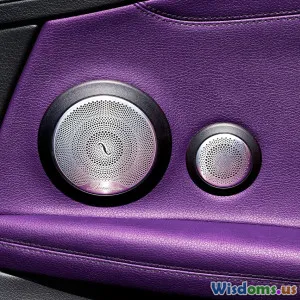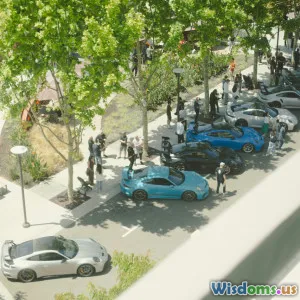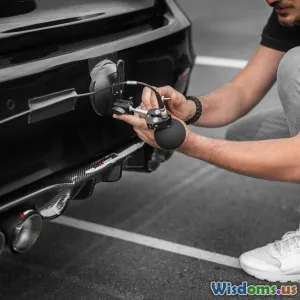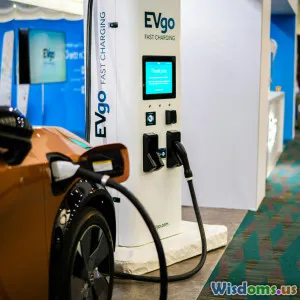
The Ultimate Comparison of Top Car Driver Assistance Systems
16 min read A detailed, practical comparison of advanced car driver assistance systems for safety, comfort, and convenience—helping you choose the perfect assistant for your driving needs. (0 Reviews)
The Ultimate Comparison of Top Car Driver Assistance Systems
Introduction: Driving Into the Future
Imagine a daily commute where your car intelligently warns you of hazards, helps you stay in your lane, and even brakes when it senses danger—all without you lifting a finger. Over the last decade, Driver Assistance Systems (ADAS) have ushered in a silent revolution on our roads, promising not just greater convenience but a dramatic reduction in accidents and fatalities. As automakers race to create smarter vehicles, drivers are left with an abundance of choices—each system boasting unique features and levels of sophistication. But which one truly stands out? What does each system offer the everyday driver, and how do these mechanisms perform under real-world conditions?
This deep-dive unpacks, compares, and demystifies today’s top driver assistance technologies—from Tesla's much-hyped Autopilot to Mercedes' technically advanced Drive Pilot, GM’s accessible Super Cruise, BMW’s Driving Assistant Plus, and rivals like Ford, Audi, and more. By focusing on practical features, real user experiences, and independent data, we arm you with the insight needed to make both smart purchase decisions and safer journeys.
The ADAS Landscape: How Did We Get Here?
The Evolution of Driver Assistance
Remarkably, some forms of driver assistance date back to the late ‘90s, primarily in luxury models. Originally conceived as basic adaptive cruise control and trajectory warning systems, ADAS now integrate hundreds of sensors, high-definition cameras, radar, lidar, and AI. According to the Insurance Institute for Highway Safety (IIHS), ADAS features have already contributed to a measurable reduction—up to 27%—in certain types of accidents such as rear-end collisions.
Today’s landscape is defined by a “racing arms” scenario, where brands each cultivate proprietary technologies and partner with software giants. From hands-on warning systems to near-autonomous cruising, consumers have a dazzling range of capability to choose from. Understanding these differences is pivotal.
Defining Levels of Assistance
Driver assistance systems are generally categorized using the SAE International levels:
- Level 1: Basic driver assistance (lane keeping OR adaptive cruise)
- Level 2: Multiple partially automated functions, but full driver supervision (e.g., Tesla Autopilot, GM Super Cruise)
- Levels 3 & 4: Some unsupervised features under limited conditions (e.g., Mercedes Drive Pilot in select roads)
- Level 5: Fully autonomous driving (not yet available commercially)
--
Meet the Leaders: An In-Depth Comparison
1. Tesla Autopilot & Full Self-Driving
Overview
Perhaps no name is invoked more in conversations around smart driving than Tesla. Elon Musk’s company positions Autopilot as an evolving suite of Level 2 features, with “Full Self-Driving” (FSD) an ambitious promise for the future—albeit with ongoing regulatory and technical challenges.
Key Features
- Traffic-Aware Cruise Control: Matches the speed of surrounding traffic.
- Autosteer: Assists with steering within clearly marked lanes.
- Navigate on Autopilot: Suggests lane changes, interchanges on highways.
- Summon/Park Assist: Allows the car to autonomously park or come to you in parking lots (limited typical scenarios).
- FSD Beta: In North America, select users can access city street automation—turns, stops, and traffic lights—though hands-on control and close vigilance are still mandatory.
Real-World Insights
A study by MIT’s AgeLab found Tesla’s system was among the most engaging, but its reliance on the driver led to lapses in long or complex scenarios. Autopilot’s “Beta” city driving function has received mixed reviews: while lane-centering and highway navigation are impressively smooth, the system occasionally makes unpredictable choices, underscoring the present need for careful human monitoring.
Ownership Quote:
"Autopilot is amazing… until you try it on less-than-ideal roads. Hands on the wheel are still a must." — 2022 Model 3 Owner, California.
2. Mercedes-Benz Drive Pilot
Overview
In 2022, Mercedes became the first automaker to receive full regulatory approval for Level 3 automated driving in Germany (USA rollout limited). Their Drive Pilot is available on S-Class and EQS.
Key Features
- Conditional Automation (Level 3): On mapped highways at speeds up to 40 mph, Drive Pilot takes over—including starting, stopping, and handling in-traffic maneuvers.
- HD Map Integration: Ultra-detailed mapping allows for anticipatory driving.
- Emergency Takeover: 10-second disengagement system if driver unresponsive.
- Integrated Redundancies: Dual controls for steering, brakes, and power in case of failure.
Real-World Insights
Mercedes’s system is designed for heavy traffic (“jam”) scenarios, excelling on German autobahns during congestion. In these circumstances, users can legally lift their hands off the wheel, routinely catching up on emails or taking a call.
European safety watchdogs described Drive Pilot as the “closest real-world application yet” of autonomous operation, but noted high speed limits (over 40 mph) remain out of reach, diminishing appeal in the U.S. until expanded.
3. GM Super Cruise (and Ultra Cruise)
Overview
General Motors' Super Cruise was the first hands-free highway driver assistance feature, debuting in the Cadillac CT6. Super Cruise leverages high-precision GPS, lidar map data, and a strict driver monitoring system to allow entirely hands-off driving on compatible highways (typically 400,000+ miles in North America).
Key Features
- Hands-Free Operation: True hands-free operation under monitored conditions.
- Driver Observation: Real-time camera monitors for driver attention and immediately issues visual/audible warnings if focus is lost.
- Automatic Lane Change: System can control passing maneuvers with traffic awareness.
- Ultra Cruise (Upcoming): GM's next-gen expansion promises city-street operations and more advanced autonomy, set to launch in select models 2024+.
Real-World Insights
Praised widely for its seamless, relaxing highway experience, Super Cruise's biggest differentiator is robust fail-safes— instances of people falling asleep at the wheel have triggered safe stop maneuvers, crucially avoiding disaster. User experience on mapped routes beats most rivals, though the restrictive scope (highways only) is limiting for mixed-use drivers.
Owner Feedback:
"Super Cruise makes my interstate commutes almost effortless… but step off a numbered highway, and it's all me again."
4. BMW Driving Assistant Professional/Plus
Overview
BMW, famed for its “Ultimate Driving Machine”, offers a thoroughly integrated assistance suite on the 7 Series, 5 Series, and iX/i7 electric models.
Key Features
- Active Cruise & Lane-Keeping: Adaptive speed management with simultaneous lane-centering.
- Steering & Lane Control Assistant: Works up to 130 mph in Europe (where allowed).
- Traffic Jam Assistant: Semi-automated driving in congested conditions (below~40 mph).
- Emergency Stop & Traffic Light Recognition: Includes advanced city and highway functions.
- Automatic Overtaking: With turn signal activation.
Real-World Insights
BMW’s interface is designed to strike a “sweet spot” between user confidence and manual pleasure. Drivers report strong performance in traffic jams, though some find the frequent torque warnings irritating. It’s rated as one of the less erratic assistants on twisty or sub-optimal roads, thanks to predictive steering algorithms.%BMW Owners appreciate its clear visuals but wish for hands-free operation to expand.
5. Ford BlueCruise (and Lincoln ActiveGlide)
Overview
Launched in 2021 on the Mustang Mach-E and F-150, Ford’s BlueCruise offers hands-free driving on 130,000 miles of “Blue Zones” highways.
Key Features
- True Hands-Free on Pre-Mapped Roads: Like GM, relies on facial recognition attention checks.
- Lane Centering and Stop-and-Go: Strong for daily highway commutes.
- Over-the-Air Updates: Improves performance and expands road coverage.
- Active Assist on Curvy Roads: Adjusts speed on curves for smoother riding.
Real-World Insights
Ford's approach emphasizes accessible tech with a straightforward interface, making it easy for new users. Critics praise touchpoints like the blue steering wheel light, clarity of notifications, and reasonably conservative operation (it won't risk a pass in tight spots). Owner reviews highlight a sense of security, though “Blue Zones” limitations lessens value off the grid.
6. Audi Adaptive Cruise Assist with Lane Guidance
Overview
Audi offers a bundle of advanced highway aids on its latest models.
Key Features
- Adaptive Cruise + Lane Stay: Blends speed and lateral positioning.
- Predictive Efficiency Assist: Uses map data to predict curves.
- Traffic Jam Assist: Hands-free at lower speeds.
Real-World Insights
Audi’s gentle steering input is praised for hassle-free commutes, while conservative disengagement on tough curves (like lane splits at construction) shows it’s designed for subtlety, not bravado. The brand’s focus on “assistance, not automation,” keeps driver involvement at the forefront—a safer bet for tech-wary users.
7. Hyundai/Kia Highway Driving Assist (HDA 2.0)
Overview
Rapid strides from Hyundai-Kia deliver solid semi-automation packed into their mainstream lineup—found in the Ioniq series, Palisade, and Kia EV6.
Key Features
- Highway Lane Centering
- Adaptive Lane Change with Signals
- Navigation-Coupled Speed Control
- Active Collision Avoidance
Real-World Insights
Excellent performance per dollar, with interface and visualization improvements in recent years. Owner forums cite reliable traffic management and surprisingly advanced behavior at entry-level price points. Slightly conservative lane changing can feel slow in heavy, fast-paced traffic, but this is by design.
Benchmarks and Showdowns: How Do They Stack Up?
Safety: Who’s Got Your Back?
- Tesla & Super Cruise: Both rank high in emergency intervention effectiveness.
- Mercedes Drive Pilot: Leads with conditional autonomy and full redundancy.
- BMW/Ford/Audi/Hyundai: Offer comprehensive basic safety, but tend to disengage early (erring on the side of caution).
- Independent Results: Euro NCAP and IIHS assign best-in-class ratings for lane keeping and emergency braking to BMW and Mercedes; Tesla earns points docked for driver supervision concerns.
User Experience & Interface
- Super Cruise & BlueCruise: Intuitive lights, unobtrusive alerts, proven ease of use even for tech beginners.
- Tesla FSD: Regular “nag” alerts and sudden disengagements can frustrate; advanced users value the frequent updates.
- Mercedes, BMW: Premium, customizable visuals; responsive to personalized driver profiles.
Road Coverage & Update Potential
- Tesla (FSD), BMW: Offers some of the widest operational contexts today, including city navigation and cross-country capability.
- GM/Ford: Restrict functionality to mapped highways, favoring safety over broader use.
- Audi/Hyundai-Kia: Expanding but limited by current infrastructure compatibility.
Cost & Availability
- Tesla: FSD bundle sits at $12,000+ (2024), though monthly plans exist ($199/month).
- Mercedes: Currently a premium, Europe-focused option with expected U.S. rollout delayed due to regulatory hurdles.
- GM/Ford: Services typically monthly/yearly subscriptions ($15–$25/month after initial trial).
- Hyundai, Audi: Included less expensive mainstream models, broadening access with competitively low upgrade premiums.
The Innovation Race: What’s Next?
The world’s largest car markets—U.S., Europe, and East Asia—have placed growing pressure on manufacturers not just to innovate but also to standardize and cross-license safety functions. Notably, in late 2023, the European Union finalized regulations requiring features like lane-keeping assist, automatic braking, and cross-traffic warnings on all new models by 2026.
Key Trends:
- Over-the-Air Updates: Tesla spearheaded this trend, but now even legacy brands provide routine upgrades that add features, extend mapped routes, or adjust AI behavior.
- Urban Expansion: Next-gen ADAS systems, like GM’s Ultra Cruise, will soon address complex city environments—managing traffic lights, unprotected turns, and erratic pedestrians.
- Luxury to Mainstream: As costs drop, expect HDA, BlueCruise, and others to appear on compact models within three years.
- Regulatory Progress: From crash avoidance to full autonomous emergency response, legal and liability standards will shape how fast the systems evolve—and become truly hands-free across all roads.
Conclusion: Choosing Your Digital Co-Pilot
With an array of carefully engineered options, finding your ideal driver assistance system requires a careful balance of safety, convenience, versatility, and trust. For those demanding frequent hands-free highway operation with gold-standard fail-safes, GM Super Cruise or Ford BlueCruise are smart bets. Tech thrill-seekers will revel in the rapid evolution of Tesla’s FSD, though it’s not devoid of quirks or controversy. Meanwhile, confidence and comfort reign supreme with German luxury—Mercedes and BMW—catapulting drivers into a new era where automation blends seamlessly with personal control.
The future rushes toward us. Yet for all the hype, each system today requires human oversight—a reminder that while our cars may get smarter, the smartest safety feature is still an attentive driver.
Further Reading and Resources
- IIHS Advanced Driver Assistance Systems Ratings
- Euro NCAP Assisted Driving Grading
- NHTSA Automated Vehicles 101
Ready to invest in a smarter ride or simply want to make your existing journey safer? Use this ultimate side-by-side to make an informed, future-forward choice.
Rate the Post
User Reviews
Popular Posts














